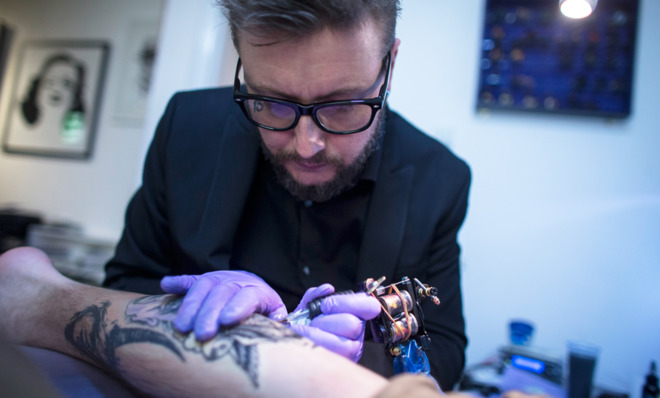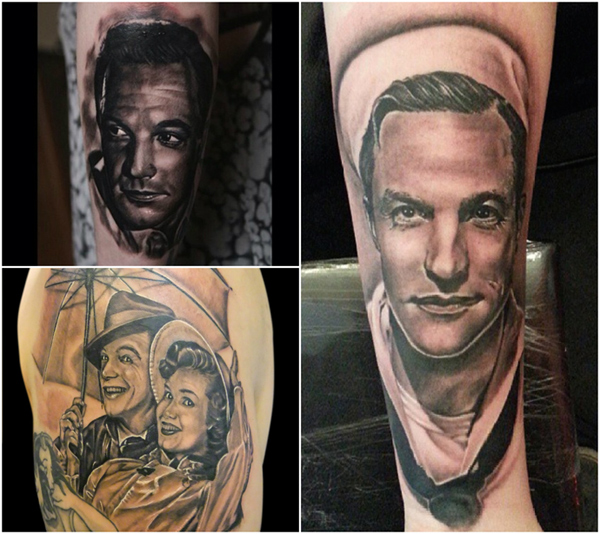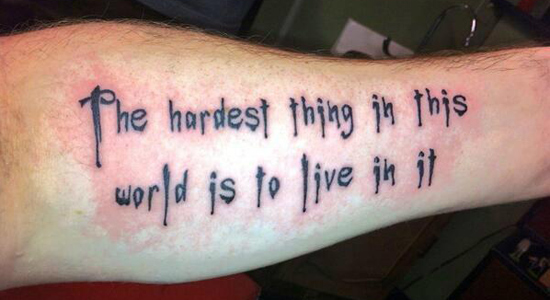What tattoos can teach us about modern fandom
What makes a person love a movie or TV show so much that they want to wear it on their skin forever? The answer is rarely simple — but always personal.

I study Gene Kelly, the classic Hollywood song-and-dance man, for a living. I publish articles on his life and career. I require my introductory film students to watch Singin' in the Rain. Once, I even taught a class focused solely on Gene Kelly's choreographic contributions to the film musical.
By extension, I also study the (very active) fandom associated with Gene Kelly. Although he has been dead nearly 20 years, devoted fans still share fan fiction, original artwork, personal blogs and Tumblrs, cosplay, video tributes, and — among the most devoted — tattoos. With ink, they literally mark themselves as Gene Kelly fans.
Over the years, I have come across dozens of Gene Kelly tattoos. Some are simple: his autograph, a profile of his dancing, a lamppost surrounded by music notes and raindrops in honor of his most famous role. Lion City Tattoos highlights the latter in a short documentary; the ad executive getting the lamppost tattoo admits to watching Singin' in the Rain "every single day when she was a kid."
Subscribe to The Week
Escape your echo chamber. Get the facts behind the news, plus analysis from multiple perspectives.

Sign up for The Week's Free Newsletters
From our morning news briefing to a weekly Good News Newsletter, get the best of The Week delivered directly to your inbox.
From our morning news briefing to a weekly Good News Newsletter, get the best of The Week delivered directly to your inbox.
But most tattoos related to Gene Kelly are elaborate, intricate portraits that so resemble the original image it’s hard to believe they’re etched on human skin. See, for example, these created by tattoo artists Sam Stokes, Marcus Ottner, and Andrew Sussman.

For decades, scholars avoided studying pleasure — and thus fandom — as it relates to media like cinema and television. For the most part, they deemed it unworthy of attention. Some scholars like Max Horkheimer and Theodor W. Adorno condemned altogether the pleasures afforded by mass-produced film, TV, music, and magazines. They saw each as a repetitive product churned out like the automobiles in Henry Ford’s factories. Such objects, Horkheimer and Adorno argued, were dangerous (as opposed to thought-provoking "high" art) because they supposedly lulled audiences into passive states of mind.
But this attitude changed in the 1980s, when scholars began seriously studying popular audiences and understanding the various pleasures they derived from watching, using, and interpreting movies, TV shows, and books. To this end, scholars learned that audiences who engage with popular culture are, in fact, not passive spectators. Rather, they actively make meaning through media.
Fans, or audiences with strong relationships and loyalty to particular cultural texts, often use media even more actively. They draw Judy Garland and Gene Kelly in amorous positions. They write fan fiction that places the leads from Singin' in the Rain in a ménage à trois. They create videos like "Let's Dance" and "Dancin' with Myself" by splicing together the star's film and/or TV appearances. And they get tattoos.
A free daily email with the biggest news stories of the day – and the best features from TheWeek.com
While fans apply tattoos for various reasons, the tattoos virtually always represent something significant in their lives. Take Donna, who got a tattoo of Gene Kelly because, as a teenager, she loved his "effortless grace and wit." Now 40, she tells me she will "never tire of seeing his face on [her] arm." After all, she explains, "tattoos are expressions of things you love and how you'd like others to see you."
Rachael, who has over 16 tattoos, commissioned her tattoo of Gene Kelly for different reasons:
I grew up dancing and competing. My specialty was tap. I wanted a tattoo to represent dance and how happy it makes me. I chose someone to represent each style of dance I studied. Gene is such an icon and, let's face it, super handsome, so he was a no-brainer as my tapper.
For Rachael, having a tattoo is like "having a string tied around your finger, but permanently." Every time she catches a glimpse of one of her tattoos, it reminds her of "things that make [her] smile."
Mark, a professional dancer in England, got a Gene Kelly tattoo for similar reasons. Kelly was "always a huge inspiration, and Singin' in the Rain was the first song [he] danced to as a professional, so it will always hold a soft spot." For Mark, the tattoo "symbolizes everything [he] does in the profession": why he does it, why he loves doing it, and what it means to others when he performs.
Hannah is an artist who uses found footage of Gene Kelly in her work — a mix of sculpture, video, sound art, and poetry. She commissioned her tattoo of Gene Kelly as "an attempt to imbue some of his spirit into [her], to channel him more effectively in the work." She had the tattoo applied to her right calf because, as she explains, "My right side is dominant and I like to think of his power influencing my movements."
Of course, Gene Kelly isn’t the only pop-cultural figure to inspire tattoo levels of devotion. Fans of franchises as diverse as The X-Files, Queer As Folk, Buffy the Vampire Slayer, and Star Wars have gone to similar lengths.
Bethan Jones writes in depth about her X-Files tattoo, a quote from one of Mulder's opening monologues. The tattoo, she argues, is "an investment that arose out of pleasure." A devout young fan of the series, Jones collected X-Files posters, joined an X-Files fan club, and wrote X-Files fan fiction. Later, she began to integrate her fandom into undergraduate, master's, and PhD work. Jones writes, "The text from which the quote was taken had meaning."
Jennifer has a tattoo inspired by the series Queer As Folk (2000-05), a superhero with the words "Always have, always will" below. She got this one because she and her best friend watched Queer As Folk, and they have always shared the fandom:
Two of the characters on the show are best friends and "Always have, always will" is the line they say to each other. So she and I got matching tattoos to symbolize our fandom and friendship. Mine is on my ankle, hers is in the middle of her back.
More soberly, another fan explains why he applied to his arm this quote from Buffy the Vampire Slayer (1997-2003), "The hardest thing in this world is to live in it":

I have struggled with depression my whole life. Buffy and Joss [Whedon] have had a big impact in my life. My tattoo is a reminder that no matter how hard things get, the hardest part of life is simply surviving. If I can survive, then anything else life throws at me is insignificant.
Last, a Star Wars enthusiast tattooed The Rebel Alliance symbol on his body not only because he loves the series, but perhaps more significantly, the "rebel" part applies directly to his life: "As an atheist and queer liberationist, I'm rebelling against my conservative Catholic past."
As diverse as these tattoos are, they’re all rooted in the same thing: the powerful, deeply personal impact that mass culture can have on our private lives. Tattoos based on fandoms are rarely a simple tribute to the movies or TV shows we love; they’re muses, reminders of a friend, acts of rebellion, testaments to survival. Tattoos may begin with a fandom — but they end with the self.
Kelli Marshall teaches courses on Seinfeld, stand-up comedy, film musicals, Spike Lee, and other fun stuff at DePaul University. Read more about her take on the media and her experiences in higher ed at kellimarshall.net.


